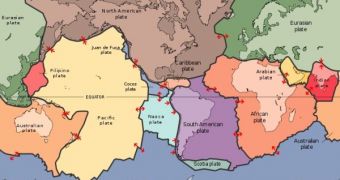According to new research results, made available by scientists at the GFZ German Research Center for Geosciences, and published in the latest issue of the journal Physics of the Earth and Planetary Interiors, the continents atop the mantle over the inner core of our planet have an insulating role, and allow heat to build up inside. In turn, the convectional forces below drive the movement of the tectonic plates, and force them apart from each other at very slow speeds.
Up to this point, there have been no mathematical-physical models to detail the movement of continental plates atop the molten rock of the mantles. Previous theories, designed by Alfred Wegener, were dismissed in the 1950s and 1960s, when the convection forces under the plates were first identified. After that, experts have only known that convection drives the movement of tectonic and continental plates, but the way in which this is achieved has remained a mystery up to this moment.
Now, GFZ researchers V. Trubitsin, M. Kaban and M. Rothacher have managed to create an explicative model, based on readings recorded through geophysical measurements and on the current displacement rates of the continents. They hypothesize that the cycle of continents on our planet repeats itself every few hundred million years.
They say that the super-continent that adorned the surface of our planet when it was first formed split in half, as North and South America separated from Europe. Australia drifted apart as well, and then Africa detached itself from the Asian plate and the Middle East. The researchers maintain that geological evidences show that the Atlantic ocean is getting wider each day, and that the Pacific is getting smaller. This means that, over millions of years, the two main continental groups, the Americas and Eurasia, will meet again on what is now the Pacific Ocean.
Due to the strong convection currents in the Earth's mantle, all stretches of land that are above sea level today will most likely be reunited in a single super-continent, and then they will break off again, to start another enormous cycle. These movements will undoubtedly be accompanied by massive earthquakes and volcanic eruptions, as previously unaffected areas will see increased tectonic activities.

 14 DAY TRIAL //
14 DAY TRIAL //